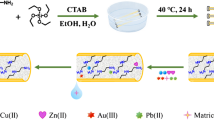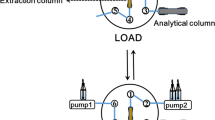Abstract
A complete characterization of a novel target-specific DNA aptamer-based miniaturized solid phase extraction (SPE)-sorbent coupled on-line to nanoLC is presented. A miniaturized oligosorbent (mOS) was prepared via the in situ sol-gel synthesis of a hybrid organic-inorganic monolith in 100 μm i.d. capillary columns using tetraethoxysilane and 3-aminopropyltriethoxysilane as precursors, followed by covalent binding of a 5′-amino-modified DNA aptamer with a C12 spacer arm specific for a molecule of small molecular weight. Ochratoxin A (OTA), one of the most abundant naturally occurring mycotoxins, was chosen as model analyte to demonstrate the principle of such an approach. The mOS was coupled on-line to RP-nanoLC-LIF. Selective extraction of OTA on several mOSs was demonstrated with an average extraction recovery above 80 % when percolating spiked binding buffer and a low recovery on control monoliths grafted with a non-specific aptamer. Reproducibility of mOSs preparation was highlighted by comparing extraction yields. Otherwise, the mOSs demonstrated no cross-reactivity towards an OTA structural analogue, i.e., ochratoxin B. Due to the high specific surface area of the hybrid silica-based monolith, the coverage density of DNA aptamers covalently immobilized in the capillaries was very high and reached 6.27 nmol μL−1, thus leading to a capacity above 5 ng of OTA. This miniaturized device was then applied to the selective extraction of OTA from beer samples. It revealed to be effective in isolating OTA from this complex matrix, thus improving the reliability of its analysis at the trace level.






Similar content being viewed by others
References
Hennion M-C, Pichon V (2003) Immuno-based sample preparation for trace analysis. J Chromatogr A 1000(1–2):29–52
Delaunay N, Pichon V, Hennion M-C (2000) Immunoaffinity solid-phase extraction for the trace-analysis of low-molecular-mass analytes in complex sample matrices. J Chromatogr B Biomed Appl 745(1):15–37
Delaunay-Bertoncini N, Pichon V, Hennion MC (2001) Immunoextraction: a highly selective method for sample preparation. LC-GC 14(3):162–172
Pichon V, Chapuis-Hugon F, Hennion MC (2012) 2.19—bioaffinity sorbents. In: Pawliszyn J (ed) Comprehensive sampling and sample preparation, volume 2: theory of extraction techniques, vol 2. Academic, Oxford, pp 359–388
Cruz-Aguado JA, Penner G (2008) Determination of ochratoxin A with a DNA aptamer. J Agric Food Chem 56(22):10456–10461
Madru B, Chapuis-Hugon F, Pichon V (2011) Novel extraction supports based on immobilised aptamers: evaluation for the selective extraction of cocaine. Talanta 85(1):616–624
Madru B, Chapuis-Hugon F, Peyrin E, Vr P (2009) Determination of cocaine in human plasma by selective solid-phase extraction using an aptamer-based sorbent. Anal Chem 81(16):7081–7086
Stoltenburg R, Reinemann C, Strehlitz B (2007) SELEX—a (r)evolutionary method to generate high-affinity nucleic acid ligands. Biomol Eng 24(4):381–403
Luzi E, Minunni M, Tombelli S, Mascini M (2003) New trends in affinity sensing: aptamers for ligand binding. TrAC Trends Anal Chem 22(11):810–818
Brumbt A, Ravelet C, Grosset C, Ravel A, Villet A, Peyrin E (2005) Chiral stationary phase based on a biostable l-RNA aptamer. Anal Chem 77(7):1993–1998
Deng Q, Watson CJ, Kennedy RT (2003) Aptamer affinity chromatography for rapid assay of adenosine in microdialysis samples collected in vivo. J Chromatogr A 1005(1–2):123–130
Romig TS, Bell C, Drolet DW (1999) Aptamer affinity chromatography: combinatorial chemistry applied to protein purification. J Chromatogr B Biomed Appl 731(2):275–284
Hadj Ali W, Pichon V (2014) Characterization of oligosorbents and application to the purification of ochratoxin A from wheat extracts. Anal Bioanal Chem 406(4):1233–1240
Chapuis-Hugon F, Boisbaudry A, Madru B, Pichon V (2011) New extraction sorbent based on aptamers for the determination of ochratoxin A in red wine. Anal Bioanal Chem 400(5):1199–1207
Michaud M, Jourdan E, Villet A, Ravel A, Grosset C, Peyrin E (2003) A DNA aptamer as a new target-specific chiral selector for HPLC. J Am Chem Soc 125(28):8672–8679
Michaud M, Jourdan E, Ravelet C, Villet A, Ravel A, Grosset C, Peyrin E (2004) Immobilized DNA aptamers as target-specific chiral stationary phases for resolution of nucleoside and amino acid derivative enantiomers. Anal Chem 76(4):1015–1020
Ravelet C, Boulkedid R, Ravel A, Grosset C, Villet A, Fize J, Peyrin E (2005) A l-RNA aptamer chiral stationary phase for the resolution of target and related compounds. J Chromatogr A 1076(1–2):62–70
Ruta J, Ravelet C, Désiré J, Décout J-L, Peyrin E (2008) Covalently bonded DNA aptamer chiral stationary phase for the chromatographic resolution of adenosine. Anal Bioanal Chem 390(4):1051–1057
Cho S, Lee S-H, Chung W-J, Kim Y-K, Lee Y-S, Kim B-G (2004) Microbead-based affinity chromatography chip using RNA aptamer modified with photocleavable linker. Electrophoresis 25(21–22):3730–3739
Chung W-J, Kim M-S, Cho S, Park S-S, Kim J-H, Kim Y-K, Kim B-G, Lee Y-S (2005) Microaffinity purification of proteins based on photolytic elution: toward an efficient microbead affinity chromatography on a chip. Electrophoresis 26(3):694–702
Deng Q, German I, Buchanan D, Kennedy RT (2001) Retention and separation of adenosine and analogues by affinity chromatography with an aptamer stationary phase. Anal Chem 73(22):5415–5421
Zhang YP, Zhang YJ, Gong WJ, Chen N, Gopalan A-I, Lee KP (2010) Novel fabrication of on-column capillary inlet frits through flame induced sintering of stainless steel particles. Microchem J 95(1):67–73
Connor AC, McGown LB (2006) Aptamer stationary phase for protein capture in affinity capillary chromatography. J Chromatogr A 1111(2):115–119
Rehder MA, McGown LB (2001) Open-tubular capillary electrochromatography of bovine β-lactoglobulin variants A and B using an aptamer stationary phase. Electrophoresis 22(17):3759–3764
Rehder-Silinski MA, McGown LB (2003) Capillary electrochromatographic separation of bovine milk proteins using a G-quartet DNA stationary phase. J Chromatogr A 1008(2):233–245
Clark SL, Remcho VT (2003) Open tubular liquid chromatographic separations using an aptamer stationary phase. J Sep Sci 26(15–16):1451–1454
Kotia RB, Li L, McGown LB (2000) Separation of nontarget compounds by DNA aptamers. Anal Chem 72(4):827–831
Charles JAM, McGown LB (2002) Separation of Trp-Arg and Arg-Trp using G-quartet-forming DNA oligonucleotides in open-tubular capillary electrochromatography. Electrophoresis 23(11):1599–1604
Clark SL, Remcho VT (2003) Electrochromatographic retention studies on a flavin-binding RNA aptamer sorbent. Anal Chem 75(21):5692–5696
Dick LW Jr, Swinteck BJ, McGown LB (2004) Albumins as a model system for investigating separations of closely related proteins on DNA stationary phases in capillary electrochromatography. Anal Chim Acta 519(2):197–205
Gao C, Sun X, Woolley AT (2013) Fluorescent measurement of affinity binding between thrombin and its aptamers using on-chip affinity monoliths. J Chromatogr A 1291:92–96
Zhao Q, Li X-F, Le XC (2008) Aptamer-modified monolithic capillary chromatography for protein separation and detection. Anal Chem 80(10):3915–3920
Zhao Q, Li X-F, Shao Y, Le XC (2008) Aptamer-based affinity chromatographic assays for thrombin. Anal Chem 80(19):7586–7593
Deng N, Liang Z, Liang Y, Sui Z, Zhang L, Wu Q, Yang K, Zhang L, Zhang Y (2012) Aptamer modified organic–inorganic hybrid silica monolithic capillary columns for highly selective recognition of thrombin. Anal Chem 84(23):10186–10190
Xu L, Shi Z-G, Feng Y-Q (2011) Porous monoliths: sorbents for miniaturized extraction in biological analysis. Anal Bioanal Chem 399(10):3345–3357
Brothier F, Pichon V (2013) Immobilized antibody on a hybrid organic–inorganic monolith: capillary immunoextraction coupled on-line to nanoLC-UV for the analysis of microcystin-LR. Anal Chim Acta 792:52–58
Mosesso P, Cinelli S, Piñero J, Bellacima R, Pepe G (2008) In vitro cytogenetic results supporting a DNA nonreactive mechanism for ochratoxin A, potentially relevant for its carcinogenicity. Chem Res Toxicol 21(6):1235–1243
Muñoz K, Vega M, Rios G, Muñoz S, Madariaga R (2006) Preliminary study of ochratoxin A in human plasma in agricultural zones of Chile and its relation to food consumption. Food Chem Toxicol 44(11):1884–1889
Turner NW, Subrahmanyam S, Piletsky SA (2009) Analytical methods for determination of mycotoxins: a review. Anal Chim Acta 632(2):168–180
Kabak B (2009) Ochratoxin A in cereal-derived products in Turkey: occurrence and exposure assessment. Food Chem Toxicol 47(2):348–352
Pfohl-Leszkowicz A, Manderville RA (2007) Ochratoxin A: an overview on toxicity and carcinogenicity in animals and humans. Mol Nutr Food Res 51(1):61–99
Barthelmebs L, Hayat A, Limiadi AW, Marty J-L, Noguer T (2011) Electrochemical DNA aptamer-based biosensor for OTA detection, using superparamagnetic nanoparticles. Sensors Actuators B 156(2):932–937
Chen J, Fang Z, Liu J, Zeng L (2012) A simple and rapid biosensor for ochratoxin A based on a structure-switching signaling aptamer. Food Control 25(2):555–560
De Girolamo A, McKeague M, Miller JD, DeRosa MC, Visconti A (2011) Determination of ochratoxin A in wheat after clean-up through a DNA aptamer-based solid phase extraction column. Food Chem 127(3):1378–1384
Soler-Illia GJAA, Sanchez C, Lebeau B, Patarin J (2002) Chemical strategies to design textured materials: from microporous and mesoporous oxides to nanonetworks and hierarchical structures. Chem Rev 102(11):4093–4138
Wight AP, Davis ME (2002) Design and preparation of organic–inorganic hybrid catalysts. Chem Rev 102(10):3589–3614
Hoffmann F, Cornelius M, Morell J, Fröba M (2006) Silica-based mesoporous organic–inorganic hybrid materials. Angew Chem Int Ed 45(20):3216–3251
Hoffmann F, Froba M (2011) Vitalising porous inorganic silica networks with organic functions-PMOs and related hybrid materials. Chem Soc Rev 40(2):608–620
Mehdi A, Reye C, Corriu R (2011) From molecular chemistry to hybrid nanomaterials. Design and functionalization. Chem Soc Rev 40(2):563–574
Zhu T, Row KH (2012) Preparation and applications of hybrid organic–inorganic monoliths: a review. J Sep Sci 35(10–11):1294–1302
Ma J, Liang Z, Qiao X, Deng Q, Tao D, Zhang L, Zhang Y (2008) Organic–inorganic hybrid silica monolith based immobilized trypsin reactor with high enzymatic activity. Anal Chem 80(8):2949–2956
Rhouati A, Hayat A, Hernandez DB, Meraihi Z, Munoz R, Marty J-L (2013) Development of an automated flow-based electrochemical aptasensor for on-line detection of ochratoxin A. Sensors Actuators B 176:1160–1166
Rhouati A, Paniel N, Meraihi Z, Marty J-L (2011) Development of an oligosorbent for detection of ochratoxin A. Food Control 22(11):1790–1796
Bazin I, Faucet-Marquis V, Monje M-C, El Khoury M, Marty J-L, Pfohl-Leszkowicz A (2013) Impact of pH on the stability and the cross-reactivity of ochratoxin A and citrinin. Toxins 5(12):2324–2340
Dohnal V, Pavlíková L, Kuca K (2010) The pH and mobile phase composition effects ochratoxin A fluorescence at liquid chromatography. J Chromatogr Sci 48(9):766–770
Acknowledgments
This work was supported by the French National Research Agency (ANR Program CESA 2010, Mycodiag Project).
Author information
Authors and Affiliations
Corresponding author
Electronic supplementary material
Below is the link to the electronic supplementary material.
ESM 1
(PDF 53 kb)
Rights and permissions
About this article
Cite this article
Brothier, F., Pichon, V. Miniaturized DNA aptamer-based monolithic sorbent for selective extraction of a target analyte coupled on-line to nanoLC. Anal Bioanal Chem 406, 7875–7886 (2014). https://doi.org/10.1007/s00216-014-8256-z
Received:
Revised:
Accepted:
Published:
Issue Date:
DOI: https://doi.org/10.1007/s00216-014-8256-z




